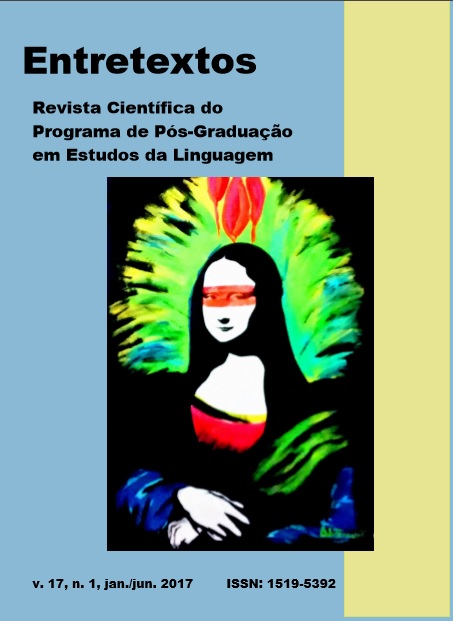The cordel as a discourse genreon teaching materials based on a linguistic variety
DOI:
https://doi.org/10.5433/1519-5392.2017v17n1p155Keywords:
Discursive genders, Didactic materials, Cordel, Regional Linguistic variation, Linguistic prejudiceAbstract
This work aims to comparate the variacionist studies and the teory of discursive genders by analyse of a cordel situated on teaching materials and its relation to the valorization of regional linguistic variation, in order to eliminate linguistic prejudices. For that, they were analised two teaching materials of Portuguese Language that shows the discursive practices with the cordel discursive gender, as know: i) 8th degree (junior high school) of Tecendo Linguagens collection, IBEP (2012) – government version, PNLD 2014; ii) 7th degree Projeto Athos: língua portuguesa, FTD (2014) – market version. In order to guide the research, they were set the following research questions: i) Is it possible to observate on teaching materials the bakhtinian’s theoretical assumptions based on the discussion about discourse genders?; ii) The didactic work with the cordel on didactic materials validates the valorization of the dialect where it’s from?; iii) May we compare didactaly linguistic register used on cordels to the educational Sociolinguistic theory?; iv) The didactic work with the cordel gender was studied with a form to eliminate linguistic prejudice? As research tools, it was used the research and analyses of cordel gender on the didactic materials added to the light of Bakhtin’s theoretical approach (2006), to Bronckart’s sociodiscursive interactionist (2003), Labov’s variationist studies (2008), and Bagno’s (2007) and Bortoni-Ricardo’s (2013) Educational Socioliguistic. In a general view, it was possible to see some work using the Bakhtin’s assumptions relative to the discursive genders; however, these materials shows a insufficient approach of the linguistic variation as a characteristic of the cordel gender.Downloads
References
BAGNO, Marcos. Preconceito linguístico. 56. ed. São Paulo: Parábola Editorial, 2015.
BAGNO, Marcos. Nada na língua é por acaso: por uma pedagogia da variação linguística. São Paulo: Parábola Editorial, 2007.
BAKHTIN, Mikhail (VOLOCHÍNOV, V.N.). Língua, fala e enunciação. In: BAKHTIN, Mikhail. Marxismo e filosofia da linguagem. 12. ed. Hucitec, 2006. p. 91-111.
BAKHTIN, Mikhail (VOLOCHÍNOV, V.N.). A interação verbal. In: BAKHTIN, Mikhail. Marxismo e filosofia da linguagem. 12. ed. Hucitec, 1995. p. 110-127.
BAHKTIN Mikhail (VOLOCHÍNOV, V.N.). Estética da criação verbal. Traducao Maria Ermantina G. G. Pereira. 2. ed. São Paulo: Martins Fontes, 1997. p. 279- 325.
BORTONI-RICARDO, Stella Maris; MACHADO, Veruska Ribeiro. (Org.). Os doze trabalhos de Hércules: do oral para o escrito. São Paulo: Parábola, 2013.
BORTONI-RICARDO, Stella Maris; ROCHA, Maria do Rosário. O ensino de português e a variação linguística em sala de aula. In: MARTINS, Marco A. ; VIEIRA, Silvia R.;TAVARES, Maria A. (Org.). Ensino de Português e Sociolinguística. São Paulo: Contexto, 2014. p. 38-55.
BORTONI-RICARDO, Stella Maris. Educação em língua materna: a sociolinguística em sala de aula. São Paulo: Parábola Editorial, 2004.
BRAIT, Beth. Mikhail Bakhtin: o discurso na vida e o discurso na arte. In: DIETZSCH, Mary Júlia. (Org.). Espaços da linguagem na educação. São Paulo: Humanitas, 1999. v. 1, p. 11-39.
BRANDÃO, Helena H. Nagamine. Gêneros do discurso na escola: mito, cordel, discurso político, divulgação científica. São Paulo: Cortez, 2000.
BRASIL. Secretaria de Educação Fundamental. Parâmetros curriculares nacionais: terceiro e quarto ciclos do ensino fundamental: língua portuguesa. Brasília, 1998.
BRONCKART, Jean-Paul. Atividade de linguagem, textos e discursos: por um interacionismo sócio-discursivo. São Paulo: EDUC, 2003.
CAMPOS, Maria Teresa R. A. et al. Projeto Athos: língua portuguesa. São Paulo: FTD, 2014.
EVARISTO, Marcela Cristina. O cordel em sala de aula. In: BRANDÃO, H. N. Gêneros do discurso na escola: mito, cordel, discurso político, divulgação científica. São Paulo: Cortez, 2000. p. 119-184.
FARACO, Carlos Alberto; NEGRI, Lígia. O falante: que bicho c esse, afinal? Letras, Curitiba, n. 49, p. 171-180, 1998.
CHAMBERS, Jack K; TRUDGILL, Peter. La Dialectología. Tradução Carmén Morán González. Madrid: Visor Libros, 1994.
LABOV, William. Padrões sociolingüísticos. Tradução Marcos Bagno, Maria Marta Scherre e Caroline Cardoso. São Paulo: Parábola, 2008.
LAMBERT, William W.; LAMBERT, Wallace E. Psicologia social. Tradução Álvaro Cabral. 3. ed. Rio de Janeiro: Zahar, 1972.
MACHADO, Irene. Gêneros discursivos. In: BRAIT, Beth (Org.). Bakhtin: conceitos-chave. São Paulo: Editora Contexto, 2005. p. 151-166.
MARTINS, Marco A.; VIEIRA, Silvia R.; TAVARES, Maria A. Contribuições da Sociolinguística brasileira para o ensino de português. In: MARTINS, Marco A.; VIEIRA, Silvia R.; TAVARES, Maria A. (Org.). Ensino de Português e Sociolinguística. São Paulo: Contexto, 2014. p. 11-35.
NASCIMENTO, Elvira Lopes. Debate na sala de aula: gênero catalizador para aprendizagens e desenvolvimento. In: BUENO, Luiza; COSTA-HÜBES, Terezinha da Conceição (Org.). Gêneros orais no ensino. São Paulo: Mercado de Letras, 2015. p. 206-237.
ROJO, Roxane. Gêneros de discurso/texto como objeto de ensino de língua: um retorno ao trivium? In: SIGNORINI, Inês (Org.). [Re]discutir texto, gênero e discurso. São Paulo: Parábola Editorial, 2008. p. 73-103.
SEVERO, Cristine Gorski. Entre a sociolinguística e os estudos discursivos: o problema da avaliação. Interdisciplinas: Revista de Estudos em Língua e Literatura, Aracajú, Ano 6, v.14, p. 7-15, jul-dez., 2011.
Downloads
Published
How to Cite
Issue
Section
License
Entretextos adota a Licença Creative Commons Attribution 4.0 International, portanto, os direitos autorais relativos aos artigos publicados são do/s autor/es.
Sob essa licença é possível: Compartilhar - copiar e redistribuir o material em qualquer suporte ou formato. Adaptar - remixar, transformar, e criar a partir do material, atribuindo o devido crédito e prover um link para a licença e indicar se mudanças foram feitas.























